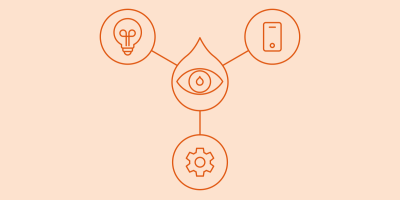Managing the Omnichannel Customer Experience
In today's interconnected world, the customer journey is more complex than ever. There are many touchpoints online and offline and your customers expect every step to reflect how they’ve already interacted with you. That means personalized content on websites, timely notifications and messages, and a consistent brand experience at every turn.
Designing and managing the omnichannel customer experience is critical to compete and thrive at any scale of business. You’re already providing a customer experience, and it’s likely on multiple channels. However, it’s probably not as positive, connected, or relevant as it could be.
Here’s a closer look at what the omnichannel customer experience is, why it’s important, and how to improve it.
What is an omnichannel customer experience?
An omnichannel customer experience is a personalized journey across all channels that updates in real time and stays relevant based on customer behavior. It ensures a seamless and consistent customer journey that allows individuals to switch between channels like websites, mobile apps, physical locations, and social media without any disruption.
By synchronizing data and coordinating interactions across these channels, an omnichannel experience enhances customer satisfaction and brand loyalty.
For example, after a customer interacts with your website, the next time they get an email from your brand or use your mobile app, it should feel like a continuation of their past interactions. The content and prompts should be personally relevant based on how they engaged with you on other channels.
Here’s a simple look at how that could flow:
- Email campaign: Personalized email about travel deals
- Website interaction: Curated page showing flights to the destination the customer clicked on
- Social media advertising: In-feed ads featuring the destination and discounted rates for the travel dates the customer had searched on the website
- Chat agent conversation: Personalized advice on booking round-trip versus multi-city
- Post-purchase engagement: Targeted follow-up communications after booking to offer in-flight meals,upgrades, or local excursions
- In-person experience: Smooth transition from online to offline, with seamless check-in and in-flight enhancements
The importance of a seamless omnichannel experience
In a world where consumers have endless options at their fingertips and the lines between online and offline are increasingly blurred, an omnichannel approach is key to attracting and retaining customers. It's not just about selling a product or service; it's about creating a relationship with the customer that's built on understanding, convenience, and trust. This starts with meeting the customer wherever they already are, and then delivering a compelling, relevant, and consistent experience every time they encounter you in their journey. And each of these encounters is dynamic and builds upon the last, creating a unified but not repetitive experience.
The importance of an omnichannel experience reflects a broader shift in consumer behavior and technological innovation, and it requires a multifaceted approach that involves integrated platforms, personalized moments, and real-time changes.
Integration across channels: Customers can switch between online and offline channels like websites, mobile apps, physical stores, and social media, experiencing a consistent brand message and service.
Personalization: Leveraging data and analytics, businesses tailor the experience to individual customer preferences and behaviors. This means everything from multilingual support to precisely timed emails and notifications.
Real-time updates: Information is updated in real time across all channels. For example, if a customer adds an item to their cart on a mobile app, it appears in their cart on the desktop website as well.
Enhanced customer support: Customer service representatives have access to the entire customer history across channels, enabling more informed and efficient support.
How to improve the omnichannel customer experience
Shortcomings in the omnichannel customer experience usually come from a lack of understanding of the customer journey, inadequate technology, or failure to fully commit to an integrated approach.
These are the main steps we recommend to improve your existing omnichannel experience or design one from scratch.
1. Choose the right platform
Content is the backbone of omnichannel experiences and you need a content management system (CMS) that’s up to the task. Your CMS needs to meet the requirements of marketing teams, integrate with your technology stack, and equip you for the future. Consider a headless CMS or hybrid headless CMS to leverage API-first capabilities that will allow you to centralize content management and publish seamlessly across all your channels. A headless system allows you to create content once and simultaneously publish it to multiple websites, mobile experiences, in-person displays, IoT devices, personal assistants, and social media.
2. Map the customer journey
To take advantage of your platforms and content production you need to know and map every important step of the customer journey. What are all the touchpoints? Where do the critical moments of engagement happen for awareness, decision-making, and purchasing?
Consider your map a living document that will update as customer behavior evolves and channels are added to your marketing mix. This customer journey map shows you the most important places customers interact with your brand and gives you a guide on how to personalize experiences for different audiences.
3. Understand your customers
Some customers might prefer to shop on your mobile app. Others never make purchases from their desktop. You might identify a whole audience that comes from Instagram that follows a certain set of behaviors you can market to. To do omnichannel CX right, you’ll need an integrated customer data platform (CDP) to create individual customer profiles.
A CDP combines data from your customer relationship management (CRM) tools, omnichannel marketing tools, website analytics, social media analytics, and other sources of customer data into a single source of truth to create 360-degree customer profiles. CDPs give marketers the insights and intelligence needed to create and optimize personalized customer experiences.
With a CDP connected to your CMS, you can serve specific content at the right moments and on the right channels to specific audiences based upon their behaviors and preferences. While you’ll create some initial personas and journey maps from preexisting info, your CDP helps you learn about your customers over time and fine-tune their experience at every step.
4. Make every interaction matter
With individual customer profiles and audience data, you can start to zero-in on the moments that personalized content has the most impact. It might be right after someone buys a certain product or after they contact customer support through chat. You might be surprised which interactions are most important to your customers but once you know, you can make those moments feel more personal and genuine.
Imagine that a customer browsed your sporting goods website for cycling shoes, even adding a pair to their cart but never finishing the transaction. You could follow-up with a personalized email for a discount on the specific shoes they were considering to encourage them to make their purchase. When they return to the site and engage with customer support via your chat function to inquire about bike clips and pedal compatibility, your support rep will be ready to assist, having already pulled up the specifications for the cycling shoes that are sitting in the customer’s online cart.
5. Deliver great customer-first experiences
As we’ve said, a great omnichannel experience is marked by personalized content that is connected and consistent across touchpoints. But how do you ensure the right content is used at the right moment in time? That’s where digital asset management (DAM) comes in. A DAM platform serves as a hub for your brand’s photos, product images, videos, collateral, and other assets to make sure you’re leveraging accurate, up-to-date, and relevant content across your channels.
So, when you combine a customer journey map with integrated customer data, engaging and consistent content, and a CMS that powers all your channels, you can put customers first every step of the way. Instead of forcing them to interact with generic marketing campaigns and hoping they convert, you turn the whole customer journey into a kind of long-form, personalized campaign.
With these capabilities, you can design customer-first experiences that are interwoven across every channel. Instead of mapping their experience to the limitations of your technology, you can build the optimal experience for each person and audience from the start.
Getting started
Managing the omnichannel customer experience is a complex but rewarding challenge. It requires a concerted effort across various departments – from marketing to IT to customer service. By understanding the customer journey, leveraging the right technology, and committing to a customer-first approach, your business can create positive customer experiences across every channel.
Acquia Digital Experience Platform (DXP) can help you deploy personalized content in a data-driven manner across every channel to create a connected and consistent omnichannel CX. It’s ready to integrate with your existing technology stack and you can learn more about it here.


